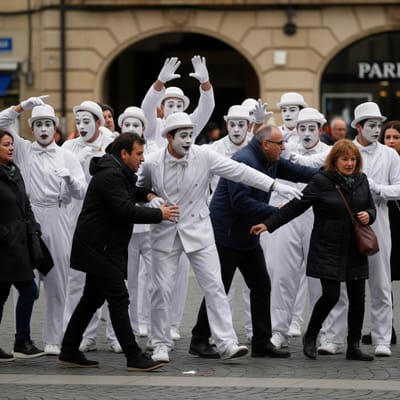The Peril of the Perpetual Poodle Parade: When Fluff Meets Fundamental Rights
Why: This idea perfectly hits Breyer's pragmatic nerve. A mandatory poodle parade is the epitome of impracticality, absurdity, and an unnecessary governmental overreach that serves no discernible "purpose." He'd likely dissect the "consequences" of such a law (traffic jams, dog-related chaos, waste of public resources) and find it utterly lacking in any rational basis. The infringement on both human liberty (being forced to participate) and animal welfare would be too much for his pragmatic sensibilities.
The fictional city of Poodleburg, a quaint municipality nestled in a valley renowned for its prize-winning pet groomers, recently enacted Ordinance 742, affectionately (or perhaps, derisively) dubbed "The Perpetual Poodle Parade Act." The premise was simple: to celebrate the city's rich canine heritage and boost tourism, every registered poodle within city limits, along with its owner, was mandated to participate in a daily parade through the town square. What started as a well-intentioned, if slightly eccentric, civic initiative quickly devolved into a constitutional quagmire, setting the stage for Poodleburg v. Poodle Owners of America, a case destined for the Supreme Court.
Justice Stephen Breyer, known for his pragmatic approach to constitutional law, would undoubtedly find himself in a philosophical wonderland, or perhaps, a dog park of jurisprudential perplexity, grappling with the absurdities of Ordinance 742. Breyer's judicial philosophy, often characterized by its focus on consequences and the practical effects of laws, would be pushed to its logical (and illogical) limits.
When Fluff Meets Fundamental Rights
Breyer's Eye Scream!
First, Breyer would likely zero in on the sheer impracticality of the ordinance. Imagine the daily logistical nightmare: hundreds, if not thousands, of poodles, ranging from miniature to standard, each with its equally bewildered owner, attempting to march in unison. The ensuing cacophony of barks, the inevitable tangles of leashes, and the unspeakable messes left in the wake of the parade would transform Poodleburg's charming town square into a chaotic spectacle. Traffic, already a minor annoyance, would grind to a halt, paralyzing commerce and daily life. The allocation of public resources to manage this daily spectacle—extra police for crowd control, sanitation crews for cleanup, and perhaps even emergency veterinary services for the inevitable paw injuries—would represent a flagrant misuse of taxpayer money. For Breyer, a law that creates more problems than it solves, and does so on such a grand and consistent scale, immediately raises red flags. It lacks a rational basis in any meaningful sense.
Beyond the logistical quagmire, the ordinance infringes upon fundamental rights, both human and canine. The forced participation of poodle owners directly impacts their liberty. The First Amendment, while often associated with freedom of speech and religion, also encompasses the freedom of association and, conversely, the freedom not to associate. Being compelled to participate in a daily parade, regardless of one's personal beliefs, schedule, or even health, represents a clear governmental overreach into the private lives of citizens. What if a poodle owner works unconventional hours? What if they are ill? What if they simply prefer a quiet afternoon at home with their beloved poodle rather than parading it down Main Street? The ordinance offers no exceptions, no room for individual autonomy. Breyer would likely view this as an arbitrary deprivation of personal autonomy, a core tenet of individual liberty. He might ask, "What legitimate governmental interest is truly served by forcing a person to walk their dog in a parade every single day?" The answer, in his pragmatic estimation, would be a resounding "none."
Furthermore, the Perpetual Poodle Parade Act raises serious questions about animal welfare. While proponents might argue it's a celebration of poodles, forcing these animals into a daily, potentially stressful, and certainly repetitive activity could be detrimental to their well-being. Poodles, like all dogs, have individual temperaments. Some might enjoy the attention, but others might find the constant noise, crowds, and forced march incredibly stressful. The potential for heatstroke on hot days, paw pad injuries from continuous walking on pavement, and the general anxiety of being in a perpetual public spectacle would be significant. Breyer, with his practical lens, would consider the unintended consequences for the animals themselves. A law that purports to celebrate animals but inadvertently causes them distress would contradict any perceived public good. He might even ponder if this constitutes a form of cruel and unusual punishment for the poodles themselves, though that argument might stretch the bounds of constitutional interpretation.
The city's stated purpose of boosting tourism and celebrating canine heritage, while perhaps noble in theory, would be meticulously scrutinized by Breyer for its legitimacy and proportionality. Is forcing daily parades the only or even the most effective way to achieve these goals? Surely, there are less intrusive and more respectful methods, such as annual festivals, dog shows, or even voluntary community events. The disproportionate burden placed on citizens and their pets, compared to the nebulous benefits of a "perpetual parade," would strike Breyer as fundamentally unreasonable. He would likely apply a rational basis review, but even under this lenient standard, the ordinance would struggle. A law must serve a legitimate government purpose, and the means chosen must be rationally related to that purpose. Here, the "means" (forced daily parades) are so extreme and burdensome that they undermine any "purpose."
Breyer's pragmatic framework would also lead him to consider the slippery slope argument. If a city can mandate daily poodle parades, what's next? Mandatory cat costume contests? Compulsory goldfish synchronized swimming performances? The potential for governmental overreach into increasingly trivial and intrusive aspects of daily life would be a significant concern. His approach emphasizes judicial restraint and upholding a balance between governmental power and individual liberty. The Perpetual Poodle Parade Act, in its sheer absurdity and invasiveness, would represent a dangerous precedent, opening the door to further infringements on personal freedom under the guise of public interest.
In the courtroom, Breyer would likely pepper the city's attorneys with hypothetical scenarios, pushing them to justify the practical implications of their law. He might ask about the impact on elderly poodle owners, on those with disabilities, or on families with multiple poodles. He would likely question the enforcement mechanisms and the penalties for non-compliance, seeking to expose the inherent unfairness and impracticality of the entire scheme.
Ultimately, Poodleburg v. Poodle Owners of America would present a fascinating case study in Breyer's jurisprudence. He would see through the fluffy facade of civic pride to the underlying infringements on liberty, the waste of public resources, and the sheer impracticality of a law that serves no legitimate purpose. The Peril of the Perpetual Poodle Parade, far from being a whimsical notion, would serve as a stark reminder that even in the most seemingly innocuous legislative endeavors, the fundamental rights of individuals and the pragmatic consequences of governmental action must always be paramount. He would likely conclude that a law so utterly devoid of rational basis and so demonstrably harmful in its practical effects simply cannot stand, illustrating the power of a pragmatic judicial philosophy to rein in even the most outlandish legislative impulses.
Video created with Gemini Pro for the Eye Scream series, a tribute to Justice Stephen Breyer.






